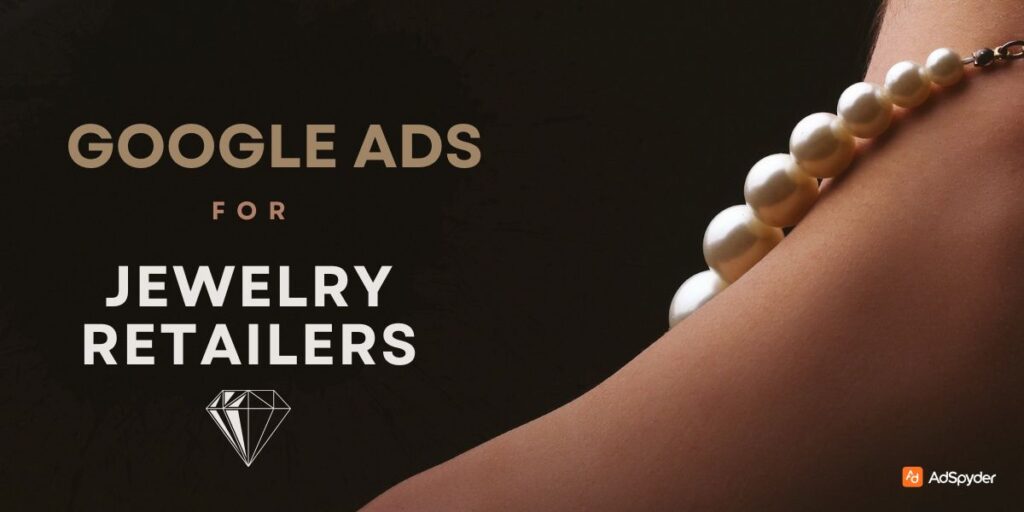As a market that relies primarily on visual impact, jewellery presents itself to customers; its perception and display techniques hold maximum importance. Jewellery retailers need an efficient and well-planned marketing method to reach potential clients among numerous radiant products available in the market. Through Google Ads, you can use their strong platform to present your elegant jewellery while reaching particular market segments, thereby directing customers to visit your online or offline store. A detailed explanation of Google Ads for Jewelry Retailers will provide essential information and specific marketing strategies to produce campaigns that drive sales and shine effectively.
Ready to Elevate your Marketing Strategy?
Why Google Ads are Essential for Jewelry Retailers
The jewellery retail market demands businesses to find ways to make themselves unique to succeed. Google Ads provides multiple essential benefits to users.
Targeted Reach
Google Ads serves as a platform that delivers advertising content to buyers who perform jewellery-related searches. Your Google Ads position is better when you target interested customers, leading to a higher return on investment. This ensures your ads are seen by people genuinely interested in your products, maximising your ROI. Imagine targeting someone searching for “engagement rings in [city]” – Google Ads makes this direct connection possible.
Visual Showcase
Products in the jewellery category demand visual appeal because they demand eye engagement. The direct search results through Google Shopping campaigns present your products with high-resolution images that allow shoppers to view and admire your jewellery creations easily.
Search Visibility
Your products will achieve top placement in search results when potential customers use particular search terms or search for specific kinds of jewellery through Google Ads. Successful interest capturing depends on being available exactly when the user exhibits buying intent.
Performance Tracking
Performance Tracking through Google Ads supplies comprehensive reports that show how your advertising campaigns function. Through the Google Ads platform, you can track performance indicators, which include impressions, clicks, conversions, and cost-per-acquisition measurements, to optimise your ad outcomes. You can monitor metrics like impressions, clicks, conversions, and cost per acquisition, allowing you to optimise your ads for better results.
Budget Control
The advertising budget under your control represents a major advantage through Google Ads. Advertisers can establish spending thresholds per day or month and modify them when necessary to maintain their financial management while achieving optimal return on investment. You can set daily or monthly limits and adjust them as needed, allowing you to manage your spending and maximise your return.
Various Ad Formats
Google Ads provides multiple advertisement options, including textual displays combined with visual content and video presentations that let you present your jewellery in diverse formats. Google Ads also presents adjustable ad formats, which enable you to deliver personalised ads according to various target audiences.
E-commerce Integration
Online store customers benefit from integrated Google Shopping services, which allow them to shop and buy jewellery items directly through your platform.
Related – Mastering Local Advertising for Premium Brands
Understanding Your Ideal Jewelry Customer

The beginning point for launching Google Ads requires specific identification of your target audience. Your advertising campaign will achieve higher success levels when you know how to understand the preferences of your desired audience along with their style and fundamental motivations. Consider these factors:
Demographics
Your target group includes individuals whose traits include age and gender, location data, specific income levels, marriage status, and career field. Which demographic do you want to focus on between young adults and professionals, along with age-designated populations?
Occasion
The customers’ purpose for jewellery purchases includes engagement rings, wedding bands, anniversaries, birthdays or regular everyday jewellery. Are they shopping for engagement rings, wedding bands, anniversary gifts, birthday presents, or everyday jewellery?
Style
Customers’ style preferences help them choose between traditional designs and contemporary styles, as well as antique pieces and handcrafted individual items. Customers’ style preferences determine their preference between classic designs, modern styles, vintage pieces, and custom creations. Do they prefer classic designs, modern styles, vintage pieces, or custom creations?
Budget
The main subject of their jewellery purchasing expenses is their budget. The budget they have lets them pick both affordable standard jewellery and high-priced designer products. What range are they looking to spend on jewellery? The viewers want to purchase either economical pieces or high-end items.
Metal and Gemstone Preferences
The customer favours certain metals, such as gold or platinum, and particular gemstones, including diamonds, sapphires, and emeralds. Do they prefer specific metals (gold, platinum, silver) or gemstones (diamonds, sapphires, emeralds)?
Shopping Habits
Users follow either digital purchasing platforms or direct store movement for their jewellery needs. Do assessments from other customers and their suggestions guide their purchasing decisions? Do they prefer online shopping or visiting brick-and-mortar stores? What about reviews and recommendations and their influence on them?
Information Sources
Jewelry consumers tap into information sources when searching for jewelry-related information. Clients seek information about jewellery from either online reviews, blogs, magazines, or social media platforms. Where do they get their information about jewellery? Do they rely on online reviews, blogs, magazines, or social media?
When you develop thorough customer profiles, your Google Ads campaigns will better engage particular target audience segments. For example, you might have a persona for “The Bride-to-Be” looking for an engagement ring and another persona for “The Fashion-Forward Individual” seeking trendy everyday jewellery.
Check Out – Google Shopping Ad Campaigns With Examples
Key Google Ad Campaign Types for Jewelry Retailers

Several Google Ad campaign types are particularly effective for promoting jewellery:
- Search Campaigns: Search Campaigns show ranked ads that match search queries about both jewellery styles and their matching occasions. Whenever someone performs a search for diamond stud earrings or gold necklaces for women, your advertisement may display right next to their search results.
- Shopping Campaigns: Google Shopping campaigns show your products right below search results as they display high-quality pictures and details about price and user feedback. This method produces top results for bringing visitors to your online store. Google Shopping campaigns allow you to showcase your products directly in search results, including high-quality images, prices, and reviews. This is a highly effective way to drive traffic to your e-commerce store.
- Display Campaigns: Targeted ads on webpages located at jewellery-related sites help you reach potential customers who enjoy online jewellery content. Attractive banner and image ads help users spot and become interested in your promotional materials.
- Remarketing Campaigns: Your promotion targets people who visited your website before and contacted your e-store. Show them the products they examined earlier and motivate them to finally buy.
Keyword Research and Targeting for Jewelry Retailers
Success in building successful Google Ads campaigns starts with selecting strong keywords. Online users who look for jewellery through search use particular terms you need to identify. The establishment of successful Google Ads campaigns begins with conducting effective keyword research. Your audience looks for jewellery items by using particular terms, so you must determine which search phrases they utilise.
Brainstorming
Start your research by writing down all possible keywords about jewellery types, gemstones, celebrations, brands, including rivals, and matching terms. Consider all possible ways that future clients would use to search for information about your product line.
Keyword Research Tools
Discover easy-to-rank keywords with Google Keyword Planner Ahrefs and SEMrush to enhance your list. Look for specific search terms that give you better results. Women who want rose gold can now choose from “rose gold pendant necklaces” in our listing.
Match Types
Understand the different keyword match types (broad, phrase, exact) and use them strategically to control how closely your ads are triggered by user searches. Using different match types together provides the most effective way to market your content.
Negative Keywords
This tool helps you focus your budget on people who will make successful purchases. If you sell only high-end jewellery, you should include terms like costume jewellery and fashion jewellery when building your campaign. Identify and exclude irrelevant keywords that might trigger your ads but are unlikely to result in conversions. This helps you refine your targeting and avoid wasting your budget on unqualified traffic. For example, if you only sell fine jewellery, you might exclude “costume jewellery” or “fashion jewellery.”
Audience Targeting
Use Google audience targeting to reach people who match your selected user profiles and habits. Reach your target jewellery customers through their style preferences and price range while viewing jewellery material on various platforms. Utilise Google’s audience targeting options to reach specific demographics, interests, and behaviours. Target jewellery enthusiasts based on their preferred styles, price points, and even their engagement with other jewellery content online.
Remarketing
Rephrase your ads to reach online visitors who already showed interest in your brand or business. When users recall these particular pieces they have seen earlier, it motivates them to interact with your shop (check products, add them to their list and make a purchase).
Custom Audiences
Develop matching audiences by importing customer data items (email addresses and phone numbers) for advertisements that hit the right audience segments.
Crafting Dazzling Ad Creatives for Jewelry Retailers

Your advertising visuals create the important first look that prospects will have for your jewellery products. Your ad creative needs to draw attention while teaching and convincing people to act.
- High-Quality Visuals: Showcase how the jewellery catches light and demonstrates expert creation. Show off your jewellery pieces by taking pictures of them on depicted customers in an atmosphere of sophistication. Use professional, high-resolution images and videos that showcase your jewellery in the best light.
- Focus on the Unique Selling Proposition: Tell potential customers how your jewellery stands out from others in the market. What special qualities does your jewellery offer, such as exclusive patterns and materials that come from trusted sources and meet personalised standards? Use your ad content to explain what makes your jewellery different from other designs.
- Use Evocative Language: Your ad copy should be concise, compelling, and tailored to the specific desires of your target audience. Your message should appeal to emotions so that people will feel a strong urge to own your jewellery collection. Consider which emotions the purchase will trigger, such as when customers buy to express their feelings of love or celebrate special occasions.
- Include a Clear Call to Action: Inform your audience how to respond through unambiguous instructions. Tell your audience exactly what you want them to do through direct commands like “Start Shopping,” “View all Products,” “Request a Free Meeting,” or “Check New Designs.”
- A/B Testing: Test multiple ad designs to find which delivers the strongest results in our marketing campaigns. Try many visual choices, writing updates, and convincing buttons to make your ads work better—track which visual content and promotional words make the biggest impact on your target customers.
Check Out – Top 10 Akshaya Tritiya Ads
Campaign Structure and Organization
A campaign needs proper structure to help us manage and improve its performance. A well-structured campaign is essential for effective management and optimisation.
- Organised Campaigns: Separate your campaigns by-products, rings, necklaces, and earrings, as well as by market segments, bridal and fashion clients, plus your main advertising aims, e-commerce purchases, and new leads. Organise your campaigns based on product category (engagement rings, necklaces, earrings), target audience segments (bridal, fashion-forward), or campaign goals (e-commerce sales, lead generation).
- Ad Groups: Place correlated keywords and ad material into individual ad groups. Your ads will match perfectly with what users look for in their search. A single ad group for diamond engagement rings needs all content linked to the same merchandise classification.
- Granular Targeting: Use granular targeting to reach specific segments of your target audience. Use precise ad targeting methods to reach exact target market segments. You can create custom ads that address individual customer groups’ requirements and preferences.
Budgeting and Bidding for Jewelry Retailers

To earn the best possible income from your digital advertising, you need to set practical spending limits and use proper bidding methods. Setting a realistic budget and implementing an effective bidding strategy is crucial for maximising your return on investment.
- Budget Allocation: Allocate your budget across your campaigns based on their potential return on investment. Transport your available funds from one campaign to another when they demonstrate better investment returns. Focus your promotional efforts on keywords and audiences where each campaign delivers a strong profit potential. Give more considerable marketing funds to marketing efforts for goods with great sales or high earnings.
- Bidding Strategies: Set your bidding plan according to what you want to achieve in each campaign. To make automation work well, you need to check the performance of Maximize Conversions and Target ROAS bidding systems regularly. You can control bidding better through manual strategies, yet you must check them regularly. E-commerce advertising works best when you set bids to drive more customer purchases. When determining bids, focus on the worth of each conversion.
- Cost Per Acquisition (CPA) Goals: Establish affordable CPA targets to control your ad spending compared to your income. Look at your cost per acquisition numbers constantly and modify your bids and marketing techniques.
- Regular Monitoring and Optimization: Keep looking at your campaign numbers and improve your bid targeting and ads. Daily adjustments help you reach your highest possible return on investment.
Measuring Success and ROI in Google Ads for Jewelry Retailers
Analysing Google Ads performance helps you know how much you earn from your advertising money and guides your following business decisions. Measuring the success of your Google Ads campaigns is crucial for understanding your return on investment and making informed decisions about future marketing efforts.
- Key Performance Indicators (KPIs): Pick the most important measurement standards that match your marketing objectives. The key performance indicators (KPIs) that jewellers need to track in their Google Ads campaigns are as follows:
- Click-Through Rate (CTR): Users click your advertisement a specific number of times.The percentage of impressions that resulted in clicks.
- Conversions: Users click on ads when a predefined number of ads is shown to them.
- Conversion Rate: Conversion Rate shows how regularly users change action after clicking the ad. The percentage of clicks that resulted in conversions.
- Cost Per Click (CPC): Your advertising budget splits equally into every click on your ad campaign.
- Cost Per Acquisition (CPA): CPA shows the expense you pay when users transform into clients.
- Return on Ad Spend (ROAS): The return on advertising investment shows how much money you make when you spend one dollar on advertising.
- Website Traffic: Link Google Ads to Google Analytics to watch website traffic and customer activities created by your promotions.
- Google Analytics Integration: Integrate your Google Ads account with Google Analytics to track website traffic and user behaviour driven by your campaigns.
- Conversion Tracking: When you add conversion tracking to Google Ads, you can see exactly what your advertisements achieve in real results. Follow different action types, including cart additions for purchase transactions and lead form submissions.
- Regular Reporting and Analysis: Make consistent reports and study results to see if your efforts have been successful. Check your findings to know which parts of your campaign succeed and which parts need improvement.
Integrating Google Ads with Your Overall Marketing Strategy
Use Google Ads to support your business marketing plan at large. Put Google Ads plans in line with your complete marketing approach to create better results.
- E-commerce Integration: Companies that sell jewellery online need Google Shopping campaigns as part of their e-commerce strategy. Update your product feed regularly with top-notch item listings that show sharp pictures plus the right costs and complete info.
- Social Media Promotion: Use your social media platforms to show your Google Ads campaigns to potential customers. Showcase your jewellery pieces in different everyday situations through social media and interact with possible customers.
- Email Marketing Integration: Use Google Ads to collect email prospects and create an email audience base. Specialise your email marketing to give potential clients exclusive discounts, plus share new product info they like.
- Offline Marketing Coordination: Match your Google Ads strategy with other marketing approaches from offline platforms. You could enhance a specific in-store offer by running Google Ads. Coordinate your Google Ads campaigns with any offline marketing efforts, such as print ads or in-store promotions. For example, you could promote a special in-store event through Google Ads.
- Local SEO: Ensure your Google My Business profile is optimised for local searches. This is especially important for jewellery retailers with physical stores.
Best Practices for Google Ads for Jewelry Retailers
These are some of the best practices that must be followed for Jewelry Retailers:
- Use High-Quality Images: Showcase your jewellery in its best light with professional, high-resolution images.
- Target Specific Jewelry Categories: Build separate advertising plans for each piece of jewellery, including rings, necklaces and earrings.
- Focus on Occasions: Align ads with market events that customers see,k including engagements, weddings, and anniversary celebrations.
- Highlight Unique Selling Propositions: Showcase how your jewellery stands out by featuring its exceptional features, whether its unique designs or ethically sourced materials.
- Offer Financing Options: Promote financing options to make your jewellery more accessible to a wider audience.
- A/B Test Your Ads: Check which ads get better results in tests between two versions at the same time.
- Monitor Your Campaigns Regularly: Keep an eye on your campaign results by looking at your key performance indicators and update them according to your findings.
- Mobile Optimization: Use mobile-friendly designs in both your advertisement and landing pages.
Common Mistakes to Avoid in Google Ads for Jewelry Retailers
These are the most commonly occurring mistakes that can be best avoided:
- Ignoring Keyword Research: Bad keyword selection forces you to spend money on advertising without achieving results.
- Using Low-Quality Creatives: Your ads will fail to attract customers when you display subpar visual content and boring text.
- Not Tracking Conversions: You cannot determine the success of your campaigns when you do not record when customers take desired actions.
- Neglecting Mobile Optimization: Despite having a small screen size, mobile users conduct frequent online searches for jewellery. Your landing pages should adjust to mobile device screens.
- Not Integrating with Other Marketing Efforts: Your Google Ads efforts should connect with all other marketing activities in your business.
Must See – Akshaya Tritiya Jewellery Ads
The Future of Google Ads for Jewelry Retailers
Google Ads for jewellery stores will probably adapt audience-matching technology while merging video advertising with online try-on functions and artificial intelligence to handle advertising performance. Success in the jewellery market depends on monitoring future advertising trends here.
Conclusion
Jewellery businesses can use Google Ads to find buyers at scale while producing sales outcomes for their company. By using these analysis standards, you can develop campaigns that produce quantifiable achievements and promote your business growth. Continual testing alongside customer understanding will help you achieve better marketing returns and meet your business targets.
FAQs for Google Ads for Jewelry Retailers
Why use Google Ads for jewellery?
Your ads gain precise audience contact while showing products and appear in searches while testing results, plus setting money limits and choosing ad looks. Also, sync your shop directly from Google.
What are the key campaign types of Google Ads for Jewelry Retailers?
Search, Shopping, Display, and Remarketing.
What makes a good jewellery ad creative?
Effective advertising depends on displaying excellent images while emphasising product differentiators using compelling words plus a direct sales message plus split experiments.
How do I target potential customers?
Keyword research, audience targeting, remarketing, and custom audiences.
How do I optimise campaigns?
To optimise my campaigns, you need to set spending limits while choosing the right bidding method and monitor performance results while understanding the data.
How do I integrate ads with marketing strategy?
E-commerce integration, social media promotion, email marketing integration, offline marketing coordination, and local SEO.
How do I measure success for Google Ads for Jewelry Retailers?
Research the results of clicks, click-through rate, sales conversions, conversion rate, and more using CPC, CPA, ROAS and website traffic through Google Analytics.




